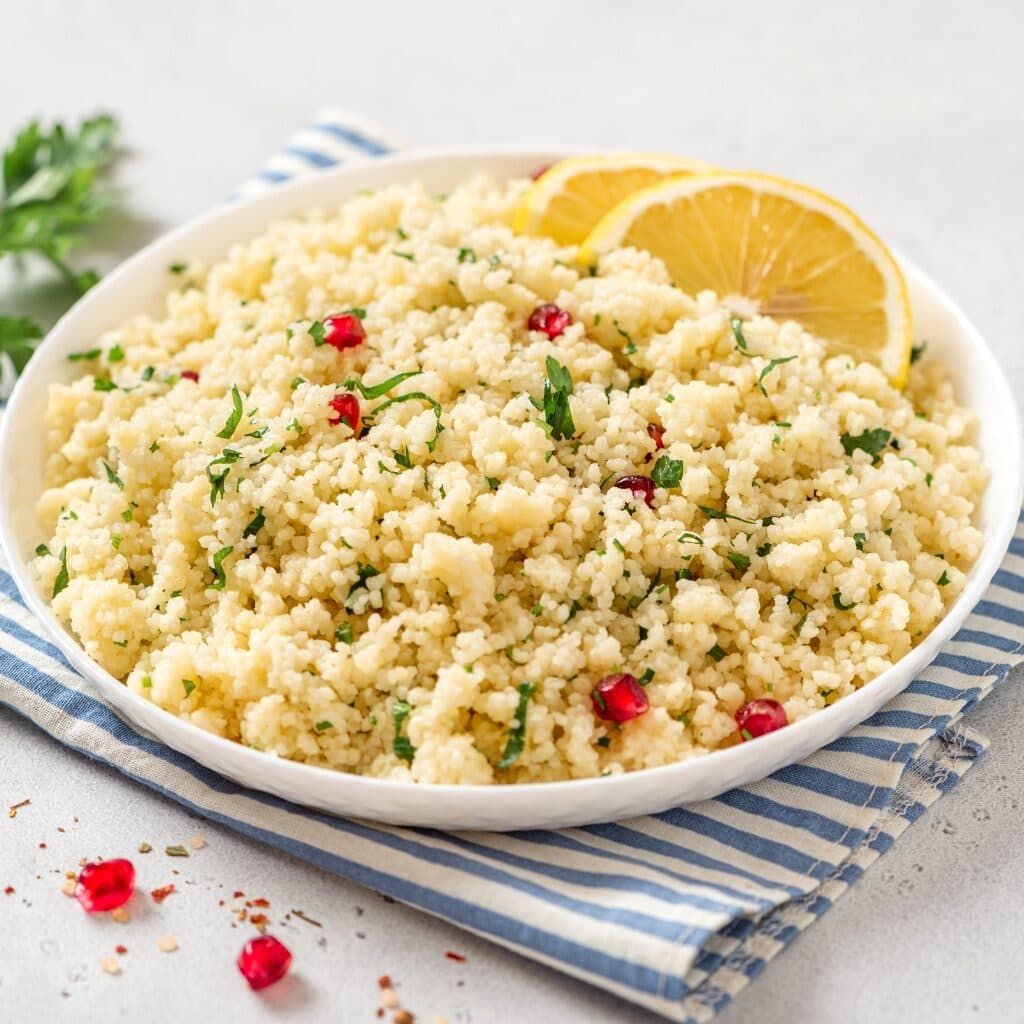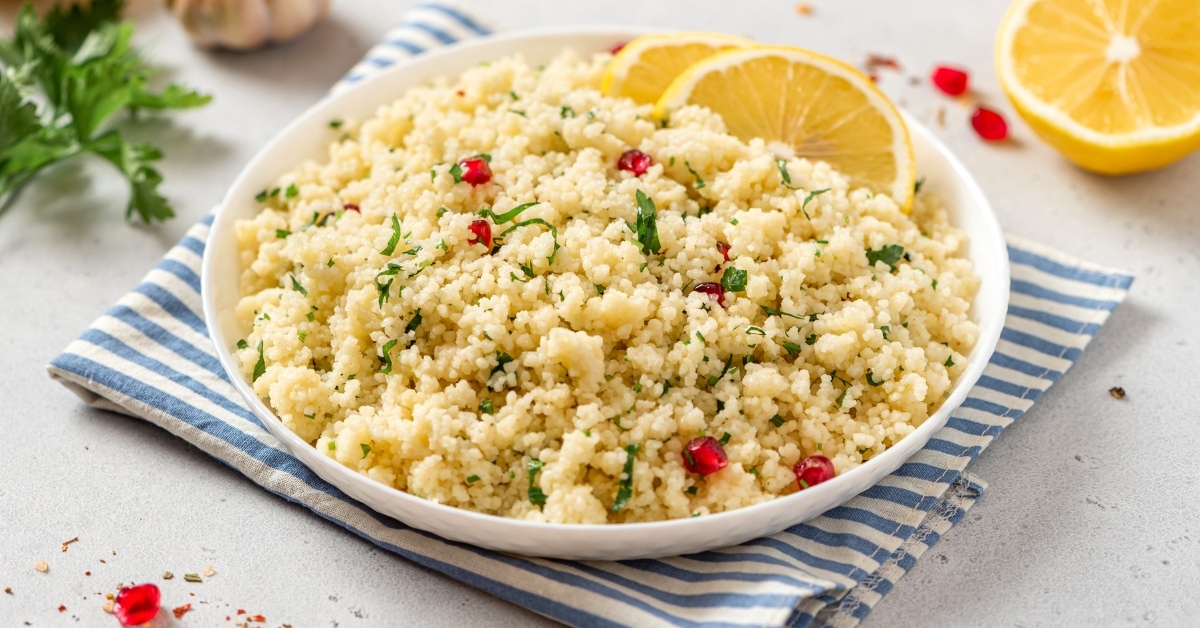What is couscous? Five years ago, I was asking that same question myself.
So, if you love Mediterranean cuisine but aren’t sure what couscous is, you aren’t alone.

Maybe you’ve seen it featured on restaurant menus and been curious about how to prepare it.
If so, you’ve come to the right place!
In this blog post, I’ll cover everything there is to know about couscous.
We’ll talk about what it is, how to cook with it, its different varieties, and more.
If you want an exciting new side dish to try, keep reading.
I’ll tell you why couscous should be a part of your next meal!
What Is Couscous?
Though it looks similar to rice, couscous is actually a type of pasta.
Specifically, it’s pasta made from water and semolina.
It has a mild, almost bland flavor that takes on the taste of other ingredients.
It’s a small, starchy grain with a whitish-yellowish color. Its shape is circular, like tiny balls.
It first appeared in North Africa in the 7th century AD and was originally made by hand.
Today, companies manufacture it on a much larger scale.
In Africa, people steamed couscous and used it in various meals at all times of the day.
Steaming is still a popular method for cooking it today. You can also fry or boil it or nuke it in the microwave.
It’s filling and often used to bulk up recipes.
It’s a great option for creating hearty meals when you don’t have a lot of meat.
Depending on what you add to it, the couscous will taste different.
Couscous cooked with lemon or lime juice can be bright and tangy.
When cooked in broth, it will have a savory flavor instead.
There are even a few sweet recipes with couscous in their ingredient lists.
Unseasoned, it has a slightly nutty but mostly mild flavor.

Couscous vs. Quinoa
Okay, it’s time for an embarrassing admission.
For the longest time, I thought quinoa and couscous were the same. I even used the words interchangeably!
So, don’t feel bad if you don’t know the difference between them.
You aren’t the only person out there who confuses these two ingredients. It’s actually pretty easy to do.
Both are small and circular, and some varieties are even a similar color! Still, they are two different ingredients.
As mentioned, couscous is made from semolina and water.
Quinoa, on the other hand, isn’t made from anything. It’s actually the seed from a flowering plant of the same name.
Vecause couscous is made from semolina (wheat flour), it’s an actual grain.
Or at least, like most pasta, it’s made from grain. It also contains gluten.
While we lump quinoa in with the grain family, it isn’t a true grain and doesn’t contain gluten.
Both ingredients have mild flavors that soak up other ingredients, though.
Therefore, you can often substitute one for the other in various recipes.

Varieties of Couscous
There are several varieties of couscous that you can buy. While they’re all couscous, they may look, feel, and taste slightly different.
Moroccan couscous is the most popular. However, you can typically find all the different varieties in local grocery stores.
Moroccan Couscous
Since Moroccan couscous is the most common, let’s discuss it first.
It has a delicious, slightly nutty flavor and is incredibly healthy.
Of course, neither of those things is why it’s so popular.
Nope. People love it because of how quickly you can cook it.
Moroccan couscous is sometimes called “instant” couscous instead.
Because it’s pre-cooked before it’s dried, it takes only about 5 minutes to prepare at home.
It also has the smallest granules of any of the couscous varieties.
Israeli Couscous
Compared to Moroccan couscous, Israeli couscous is slightly larger. It gets its name because it was created in Israel.
It’s also slightly chewier and more pasta-like than Moroccan couscous.
Because it’s larger than Moroccan couscous, cooking it takes longer.
Some people mistakenly refer to it as “pearl couscous.” However, that’s actually something entirely different.
Israeli Couscous vs. Pearl Couscous
Speaking of pearl couscous, let’s talk about it, too. It looks remarkably similar to Israeli couscous.
However, when placed side by side, their differences are apparent.
Pearl couscous is larger and has a more perfectly shaped circular look.
They’re also made differently. Israeli couscous is semolina and water that has been dried.
Steaming is its most popular preparation method.
Pearl couscous, though, is often made with bulgur wheat instead.
It’s also toasted instead of dried, and most people cook it by boiling it.
Whole Wheat Couscous
Both Moroccan and Israeli couscous come in whole wheat varieties.
Typically, whole wheat couscous is made from whole wheat durum flour.
This makes it a healthier option than regular couscous. Most notably, it’s higher in fiber and protein.
It still tastes similar to non-whole wheat couscous. (Though its flavor may be a bit more noticeable.)
You also prepare it the same way you would traditional couscous.
Lebanese Couscous
Also known as Moghrabieh, Lebanese couscous is the largest couscous variety of all.
It’s almost as big as most peas! That means it also takes the longest time to cook.
You can purchase it dried like most other couscous varieties.
However, you can sometimes find it fresh, as well. If you buy it fresh, you must cook it three times before it’s ready.
Because of its large size, it’s a popular couscous variety for soups and stews.

Couscous Uses
I just mentioned soups and stews and talked earlier about couscous as a side dish.
However, those are only a few ways to use this versatile food.
It also tastes fantastic when added to salads or used as a sweet dessert base.
You can also use it as a bed for fish, chicken, or other meats.
Couscous doesn’t have much of a flavor on its own. Some of it, particularly the whole wheat varieties, are somewhat nutty.
However, like rice, it’s largely tasteless by itself.
That makes it a fantastic base for experimenting with ingredients, spices, and seasonings.
You can pretty much use it any way you want.
Your imagination and available ingredients are your only limits.
How to Cook With Couscous
The way you prepare couscous will mainly depend on which type you have.
For example, cooking Moroccan (or instant) couscous is a breeze.
Simply add some water to a skillet or saucepan. You need about a cup and a half.
Once it starts to boil, remove it from the heat and add the couscous.
Let the couscous soak in the water for about 5 minutes. Then, vigorously fluff it with a fork.
And voila! You have an almost-instantaneous side dish ready to serve! You can also make it in the microwave.
Other varieties of couscous may take more work.
The traditional method for cooking couscous is steaming it. In Morocco, they use a device called a couscoussier.
You can achieve the same effects by placing a colander inside a stockpot.
Another option is to boil the couscous. Here are the steps for doing that:
- Liberally grease a saucepan with butter.
- Add 1 cup of couscous to the greased pan. Swish the pan around to thoroughly coat the couscous in the butter.
- Add 1-1/2 cups of water to the saucepan.
- Bring the mixture to a boil.
- Reduce the heat to low, and place the lid on the saucepan.
- Cook it until the liquid is completely absorbed. Then, remove it from the heat and serve.
Remember to add your seasonings and other ingredients as desired!










